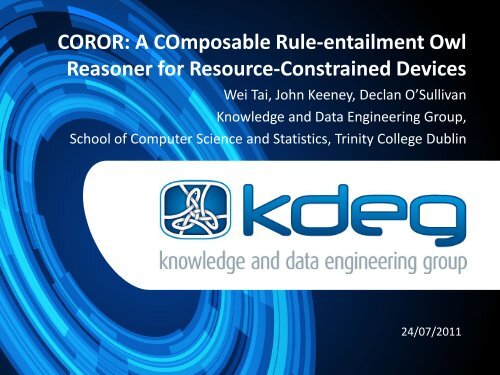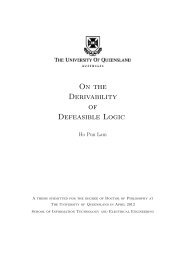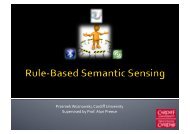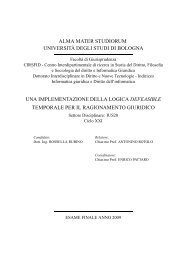COROR: A COmposable Rule-entailment Owl ... - Defeasible Logic
COROR: A COmposable Rule-entailment Owl ... - Defeasible Logic
COROR: A COmposable Rule-entailment Owl ... - Defeasible Logic
Create successful ePaper yourself
Turn your PDF publications into a flip-book with our unique Google optimized e-Paper software.
<strong>COROR</strong>: A <strong>COmposable</strong> <strong>Rule</strong>-<strong>entailment</strong> <strong>Owl</strong><br />
Reasoner for Resource-Constrained Devices<br />
Wei Tai, John Keeney, Declan O’Sullivan<br />
Knowledge and Data Engineering Group,<br />
School of Computer Science and Statistics, Trinity College Dublin<br />
24/07/2011
Background and motivation<br />
• The Semantic Sensor Network (SSN) is a recently emerged research<br />
strand using Semantic Web technologies, in particular OWL and its<br />
reasoning technologies, to solve problems encountered in traditional<br />
sensor network systems, e.g.<br />
• improving interoperability in heterogeneous environment,<br />
• enabling intelligent data processing,<br />
• enabling intelligent management.<br />
• A important research facets within SSN is the demand for “on-device”<br />
semantic reasoning, e.g.<br />
• Information filtering in context-aware mobile personal information system,<br />
• localized fault diagnosis in wireless sensor network,<br />
• context-addressable messaging services in mobile ad-hoc networks.<br />
2
Example<br />
• Context addressable<br />
messaging architecture<br />
• An OWL reasoner is used<br />
to perform address<br />
resolving.<br />
• Terminological data are<br />
stored in LOnt, and<br />
context data are stored in<br />
database.<br />
• Implemented on Nokia<br />
N800.<br />
Further reading<br />
M. Koziuk, J. Domaszewicz, R.<br />
Schoeneich, M. Jablonowski, and P.<br />
Boetzel, "Mobile Context-Addressable<br />
Messaging with DL-Lite Domain Model,"<br />
in Proc. European Conf. on Smart Sensing<br />
and Context (EuroSSC’08), 2008.<br />
3
Existing resource-constrained OWL<br />
reasoners<br />
• MiRE4OWL<br />
• Forward-chaining RETE-based OWL reasoner,<br />
• Unoptimized internal reasoning algorithm,<br />
• C++ for PPC.<br />
• μOR<br />
• Backward-chaining resolution-based OWL reasoner,<br />
• Scales well for large amount of instance data,<br />
• Suitable for small terminological box,<br />
• CDC compatible.<br />
• Bossam<br />
• Forward-chaining RETE-based OWL reasoner,<br />
• Concentrated on web-friendly and distributed reasoning,<br />
• CDC compatible.<br />
• Others<br />
• E.g. the one in MCA (J2ME but no further information on the platform), KRHyper and so on.<br />
• They are designed for relatively “more powerful” mobile devices, e.g. mobile<br />
phone or PDA, rather than highly constrained mobile devices, e.g. sensors.<br />
4
<strong>COROR</strong>: an overview<br />
• <strong>COROR</strong> is a <strong>COmposable</strong> <strong>Rule</strong>-<strong>entailment</strong> <strong>Owl</strong> Reasoner for resourceconstrained<br />
devices.<br />
• Forward-chaining RETE-based OWL reasoner.<br />
• Incorporates two novel reasoner composition algorithms to reduce the memory<br />
footprint, i.e.<br />
• selective rule loading algorithm, and<br />
• two phase RETE algorithm.<br />
• <strong>COROR</strong> is referred to as composable as it dimensions reasoning<br />
algorithm on-the-fly according to the semantic features of the ontology<br />
to be reasoned, especially the OWL constructs.<br />
5
Selective rule loading algorithm<br />
• The selective rule loading algorithm selectively load rules into a reasoner<br />
depending on the reasoning capabilities required.<br />
• According to the rule-construct dependency relationship.<br />
• Loads only OWL inference rules required to reason the particular ontology.<br />
connectWith type SymmetricProperty<br />
node1 type MotionSensor<br />
node0 type MotionSensor<br />
MotionSensor subClassOf Sensor<br />
node1 connectTo node0<br />
Analyse for<br />
constructs<br />
type<br />
SymmetricProperty<br />
subClassOf<br />
Selectively<br />
loading rules<br />
rdfs9<br />
rdfs3<br />
RETE Engine<br />
rdfs9: (v subClassOf w), (u type v) (u type w)<br />
rdfp3: (p type SymmetricProperty), (v p w) (w p v)<br />
rdfp4: (p type TransitiveProperty), (u p v), (v p w) (u p w)<br />
……<br />
Results<br />
6
A short introduction to RETE<br />
• RETE is a fast pattern matching algorithm for forward-chaining production systems. It<br />
performs pattern matching using a network structure termed as RETE network.<br />
(?v owl:someValuesFrom ?w), (?v owl:onProperty ?p), (?u ?p ?x), (?x rdf:type ?w) (?u rdf:type ?v)<br />
Fact base<br />
Facts<br />
Alpha network<br />
Beta network<br />
v someValuesFrom w v onProperty p u p x x type w<br />
v = v<br />
p = p<br />
Inferred<br />
Facts<br />
x = x<br />
w = w<br />
Fire
Two-phase RETE algorithm<br />
• The two-phase RETE algorithm uses an interrupted RETE construction<br />
mechanism to build a customized RETE network.<br />
• The alpha network is constructed<br />
• Common condition node sharing<br />
• RETE construction is interrupted by an initial fact matching after the construction of<br />
the alpha network to collect some information about the ontology, e.g.<br />
• Number of partially matched facts for each condition node (in use),<br />
• Selectivity between two joining alpha nodes (potential),<br />
• and etc.<br />
• Rather than applied beta network optimization heuristics directly, they are applied<br />
using the collected information to construct a customized beta network, i.e.<br />
• Most specific condition first<br />
• The number of partially matched facts for each condition node is used as its<br />
specificity.<br />
• Connectivity<br />
8
An example<br />
(?v owl:someValuesFrom ?w), (?v owl:onProperty ?p), (?u ?p ?x), (?x rdf:type ?w) (?u rdf:type ?v)<br />
Fact base<br />
Facts<br />
Alpha network<br />
v someValuesFrom w v onProperty p u p x x type w
An example<br />
(?v owl:someValuesFrom ?w), (?v owl:onProperty ?p), (?u ?p ?x), (?x rdf:type ?w) (?u rdf:type ?v)<br />
Fact base<br />
Facts<br />
Alpha network<br />
v someValuesFrom w v onProperty p u p x x type w
An example<br />
(?v owl:someValuesFrom ?w), (?v owl:onProperty ?p), (?u ?p ?x), (?x rdf:type ?w) (?u rdf:type ?v)<br />
Fact base<br />
Facts<br />
Alpha network<br />
v someValuesFrom w v onProperty p x type w u p x<br />
v = v<br />
Beta network<br />
w = w<br />
x = x<br />
p = p<br />
Fire
An example<br />
(?v owl:someValuesFrom ?w), (?v owl:onProperty ?p), (?u ?p ?x), (?x rdf:type ?w) (?u rdf:type ?v)<br />
Fact base<br />
Facts<br />
Alpha network<br />
Beta network<br />
v someValuesFrom w v onProperty p x type w u p x<br />
v = v<br />
w = w<br />
Inferred<br />
Facts<br />
x = x<br />
p = p<br />
Fire
Implementation<br />
• <strong>COROR</strong> is implemented<br />
• In J2ME<br />
• CLDC 1.1 conformant.<br />
• Based on μJena,<br />
• Enabling owl ontology reading, parsing and manipulation,<br />
• Requiring a volume of code refactoring as μJena does not originally support for<br />
owl reasoning.<br />
• On Sun SPOT emulator.<br />
• Using <strong>entailment</strong>s and atomic query as key reasoning tasks, combining which are<br />
enough to simulate common reasoning tasks.<br />
• Four composition modes<br />
• Non-composable mode (Original RETE)<br />
• Selective rule loading mode<br />
• Two-phase RETE mode<br />
• Hybrid mode<br />
13
Experiment design<br />
• Metrics<br />
• Memory<br />
• Reasoning time<br />
• Experiments include<br />
• Evaluation and comparison between different composition modes of <strong>COROR</strong>.<br />
• Performed on Sun SPOT emulator.<br />
• Evaluation and comparison between <strong>COROR</strong> and other reasoners, i.e.<br />
• Jena, Bossam (a mobile reasoner, CDC only), BaseVISor (time only), OWLIM, and Pellet.<br />
• MiRE4OWL and μOR are not accessible.<br />
• Performed on desktop due to the other reasoners cannot run on Sun SPOT.<br />
• Selected ontology include 17 well-known ontologies from different domains<br />
• Relatively free of error<br />
• Small to medium sized<br />
• Avoid over-/under- use of some owl constructs<br />
14
Experiment results (memory-1)<br />
Memory(KB)<br />
2,500<br />
2,000<br />
1,500<br />
1,000<br />
500<br />
Noncomposable<br />
Selective <strong>Rule</strong> Loading<br />
Two-Phase RETE<br />
Hybrid<br />
0<br />
miniTambis<br />
food<br />
Biopax<br />
mad_cows<br />
FOAF<br />
Mindswapper<br />
Beer<br />
University<br />
Koala<br />
OWLSprofile<br />
Teams<br />
15
Experiment results (time-1)<br />
350<br />
517s<br />
609s 416s 760s 836s<br />
Time(sec)<br />
300<br />
250<br />
200<br />
150<br />
100<br />
Noncomposable<br />
Selective <strong>Rule</strong> Loading<br />
Two-Phase RETE<br />
Hybrid<br />
50<br />
0<br />
miniTambis<br />
food<br />
Biopax<br />
foaf<br />
mad_cows<br />
Mindswapper<br />
Beer<br />
University<br />
Koala<br />
OWLSprofile<br />
Teams<br />
16
Experiment results (memory-2,<br />
Coror-hybrid)<br />
35<br />
30<br />
25<br />
Coror Jena Bossam<br />
OWLIM<br />
Pellet<br />
Memory Usage (MB)<br />
20<br />
15<br />
10<br />
5<br />
0<br />
NATO<br />
tambis-full<br />
pizza<br />
amino-acid<br />
wine<br />
ATK-Portal<br />
miniTambis<br />
food<br />
Biopax<br />
mad_cows<br />
FOAF<br />
Mindswapper<br />
Beer<br />
University<br />
Koala<br />
OWLS-profile<br />
Teams<br />
17
Experiment results (time-2,<br />
Coror-hybrid)<br />
10<br />
9<br />
Coror<br />
Jena<br />
8<br />
Bossam<br />
BaseVISor<br />
Reasoning Time (sec)<br />
7<br />
6<br />
5<br />
4<br />
3<br />
2<br />
OWLIM<br />
Pellet<br />
1<br />
0<br />
NATO<br />
tambis-full<br />
pizza<br />
amino-acid<br />
wine<br />
ATK-Portal<br />
miniTambis<br />
food<br />
Biopax<br />
mad_cows<br />
FOAF<br />
Mindswapper<br />
Beer<br />
University<br />
Koala<br />
OWLS-profile<br />
Teams<br />
18
Discussion based on the empirical<br />
results<br />
• All composable modes require less memory and reasoning time than the<br />
noncomposable mode<br />
• The two-phase RETE and Hybrid uses a lot less memory than the other modes as for<br />
this rule set the two-phase RETE algorithm can optimize the RETE structure as if<br />
unused rules are “removed” so the hybrid mode (combining the two-phase RETE<br />
algorithm and the selective rule loading algorithm) does not gain much more<br />
memory/time reduction comparing to the two-phase RETE algorithm.<br />
• Use the least memory among all evaluated reasoners while have<br />
reasoning time comparable to Jena forward chaining reasoner.<br />
• For small ontology (which are expected to be applied on sensors) <strong>COROR</strong> uses much<br />
less memory than the others.<br />
19
Conclusion and future work<br />
• Conclusion<br />
• Motivation<br />
• To enable intelligence on the edge of sensor network.<br />
• State of the art mobile OWL reasoners<br />
• <strong>COROR</strong> the composable reaoner<br />
• Two composition algorithms: the selective rule loading algorithm and the two-phase<br />
RETE algorithm.<br />
• Experiments design and results<br />
• Two experiments<br />
• Results<br />
• <strong>COROR</strong> uses much less memory without sacrificing time performance.<br />
• Future work includes<br />
• More heuristics can be applied during the RETE network construction phase, and more<br />
information can be collected.<br />
• Support conjunctive query languages e.g. SPARQL.<br />
• OWL 2 support.<br />
20
Thank you<br />
Questions?<br />
21
Two-phase RETE algorithm (cont’d)<br />
<strong>Rule</strong> set<br />
RETE Engine<br />
Construct α-network<br />
v subClassOf w<br />
u type v p type SymmetricProperty v p w<br />
Initial matching<br />
Ontology<br />
v subClassOf w u type v p type SymmetricProperty v p w<br />
Collects information and β-<br />
network construction resumes<br />
Reasoned<br />
Ontology<br />
Outputs reasoned<br />
ontology<br />
v subClassOf w u type v p type SymmetricProperty v p w<br />
22
An analytical comparison between<br />
composition algorithms<br />
• Reasoning algorithm independence:<br />
• Selective rule loading algorithm: applicable on all rule-based reasoning algorithm, does<br />
not require changes in the reasoning algorithm itself, and relatively easy to implement.<br />
• Two-phase rete algorithm: applicable only on RETE algorithm, require change in RETE,<br />
and relatively hard to implement.<br />
• Semantic independence:<br />
• They both are semantic independent.<br />
• Flexibility in handling changes:<br />
• Addition can be handled incrementally by the two-phase RETE algorithm however may<br />
introduce unseen owl constructs requiring the re-execution of the selective rule<br />
loading algorithm.<br />
• Simple deletion may cause logical inconsistency so re-execution is required for both<br />
algorithms.<br />
23





